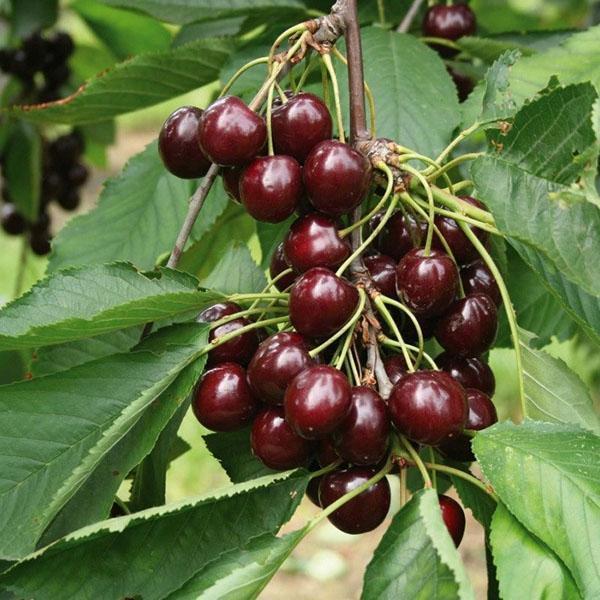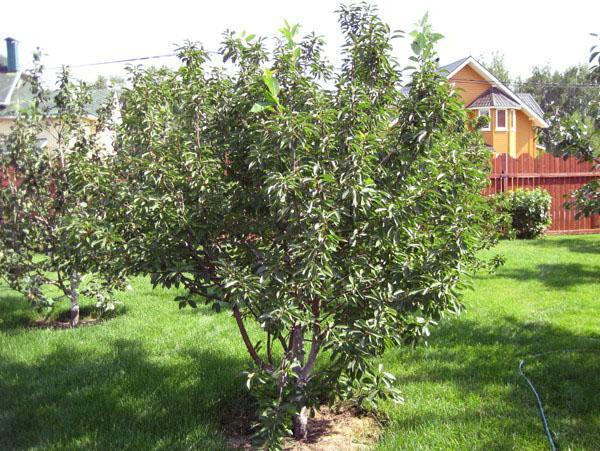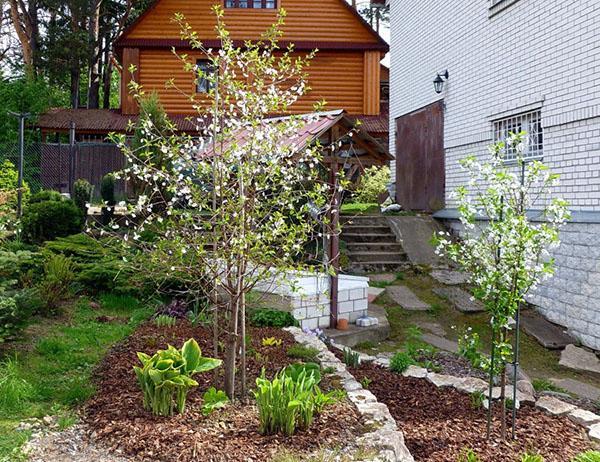Acquaintance with the amazing Shokoladnitsa cherry varieties
 Breeders offer many varieties of cherries that are popular in Russia. Among the noteworthy ones is the Shokoladnitsa cherry, a description of the variety, its strengths and features will help the gardener get an idea of the culture and make the right choice of a plant for growing on a personal plot.
Breeders offer many varieties of cherries that are popular in Russia. Among the noteworthy ones is the Shokoladnitsa cherry, a description of the variety, its strengths and features will help the gardener get an idea of the culture and make the right choice of a plant for growing on a personal plot.
The variety of domestic selection was obtained by specialists from the All-Russian Research Institute of Selection of Fruit Crops based on Cherry Consumer goods black and Lyubskaya. When creating the Shokoladnitsa cherry shown in the photo, the author's team of scientists saw the goal of obtaining a fruitful frost-resistant variety with compact trees of medium and small sizes. At the same time, the fruits ripening on them should be attractive and have an excellent dessert taste.
The task of the Oryol breeders A.F. Kolesnikova, M.V. Mikheeva and T.A. Trofimov was carried out, and in 1996 the new variety was successfully entered into the State Register, and also recommended for cultivation in the Central region of Russia.
External signs and features of the Chocolate Cherry variety

- reduces the risk of spreading fungal and bacterial diseases;
- reduces the availability of fruits and foliage to cherry pests;
- facilitates harvesting ripe berries.
The trunk and skeletal branches of the tree are covered with brown, sometimes grayish bark. Young, not yet lignified shoots have a greenish tint. Leaves emerge from conical buds up to 4 mm long, tightly pressed to the branches. The leaf plate of the Chocolate variety cherry has a shape close to an oval, pointed at the base and at the end. The edges are serrated. On the leaves, a central vein is clearly visible, turning into a strong stalk 1.5–2 cm long with a reddish color noticeable at the base. The lower part of the leaf is lighter than its front surface.
According to the description of the Shokoladnitsa cherry variety, the trees bloom together in the period from 15 to 18 May. Flower buds are larger than usual. In one inflorescence, as a rule, there are three flowers on elongated reddish-green pedicels up to 35–40 mm long. The rim diameter is 15–18 mm. Petals are white, loosely located around the future ovary.
 Flowers are readily visited by pollinating insects.
Flowers are readily visited by pollinating insects.
Gardeners who want to achieve high yields should take into account that the Shokoladnitsa cherry variety is self-pollinated, that is, the formation of an ovary occurs even if there is only one fruit tree of this variety on the site.
This is a significant advantage, but experienced gardeners prefer to play it safe and do not limit their choice only to the Chocolate Girl. As an additional pollinator for the plant, cherries of the varieties Vladimirskaya, Lyubskaya, Studencheskaya, Turgenevskaya are planted nearby. These varieties themselves are worthy of the attention of owners of personal plots, and will provide a bountiful harvest at Shokoladnitsa.
Under favorable weather conditions, harvesting in the middle lane begins from the second week of July. Four-year-old trees enter the fruiting season, the maximum age of stably fruiting plants is 15–20 years.
 Ripe cherries of the Shokoladnitsa variety, as in the photo, have a harmonious almost rounded shape and a characteristic maroon, almost black color. The average berry is 16.5–17 mm high, 19 mm wide and 17 mm thick. Weight ranges from 3.5 to 4 grams. The pulp is dense, dark red, juicy. The share of the yellowish round stone, which is easily lagging behind the pulp, accounts for only 8-10% of the fruit weight.
Ripe cherries of the Shokoladnitsa variety, as in the photo, have a harmonious almost rounded shape and a characteristic maroon, almost black color. The average berry is 16.5–17 mm high, 19 mm wide and 17 mm thick. Weight ranges from 3.5 to 4 grams. The pulp is dense, dark red, juicy. The share of the yellowish round stone, which is easily lagging behind the pulp, accounts for only 8-10% of the fruit weight.
When describing the Shokoladnitsa cherry variety, it is indicated that ripe fruits accumulate up to 12.4% sugar and contain only 1.6% acids. This provides the berries with a good, closer to sweet taste, rated by professional tasters at 3.8–4 points. In the conditions of industrial horticulture, the Shokoladnitsa cherries yield 77–97 centners of berries per hectare.
With proper care and the right planting site, a gardener can get about 15 kg of vitamin products from one tree.
Planting and caring for cherries Shokoladnitsa
 Cherries and other stone fruits do not favor acidic, overly dense, moisture-accumulating soil. Cherry variety Shokoladnitsa, according to the description and accumulated growing experience, is no exception. Therefore, elevated areas are chosen for planting:
Cherries and other stone fruits do not favor acidic, overly dense, moisture-accumulating soil. Cherry variety Shokoladnitsa, according to the description and accumulated growing experience, is no exception. Therefore, elevated areas are chosen for planting:
- with light aerated soil, into which mineral and organic fertilizers are introduced before planting the crop, and if necessary, deacidify;
- protected from cold winds, but completely exposed to the sun;
- with groundwater located at least one and a half meters from the surface.
To facilitate acclimatization and caring for Shokoladnitsa cherries, planting is carried out in April, before the buds open, or in September, when it is still warm and the tree has time to get used to its new habitat. Suitable for planting are one-year-old seedlings with a height of 1 to 1.5 meters, with developed roots up to 20-30 cm long and a lignified stem with a thickness of at least 10-15 mm.
Landing is standard. For young trees, pits are prepared with a diameter and depth of about 70 cm.The soil is mixed with potash, phosphorus and nitrogen fertilizers. If organics are used, it is better to take well-rotted fertilizers that are not capable of burning the delicate root system of cherries.
When diving into a hole, it is important not to deepen the root collar. A reliable support is provided for each seedling. After backfilling, the soil is compacted, watered and sprinkled with organic mulch.
 In order to avoid excessive growth and thickening of the crown of the Shokoladnitsa cherry variety, as in the photo, they must be cut off. It is more convenient to do this in the spring, before the first leaves appear. Old, weak, with signs of disease and pest damage are subject to pruning.
In order to avoid excessive growth and thickening of the crown of the Shokoladnitsa cherry variety, as in the photo, they must be cut off. It is more convenient to do this in the spring, before the first leaves appear. Old, weak, with signs of disease and pest damage are subject to pruning.
Special attention is paid to the symptoms of infection with moniliosis and coccomycosis, to which this cherry variety has no immunity.
For the same purpose, pruning is combined with the treatment of plantings with systemic fungicides or Bordeaux liquid. Re-spraying with chemicals is performed in the second half of flowering.
Caring for Shokoladnitsa cherries includes watering trees and feeding them. Although the plants are classified as drought-resistant, during the flowering and ripening period of berries, moisture for cherries is extremely necessary. For one tree at watering there should be at least 3-5 buckets of settled warm water.
Since autumn, potash and phosphorus supplements are added under the crowns of fruit trees, in spring cherries need "food" for rapid active growth, so they are fed with nitrogen-containing compounds. If the planting and caring for the Chokoladnitsa cherries is carried out correctly, the plants give a stable growth already in the first year of life, and in the fourth year they begin to bear fruit.